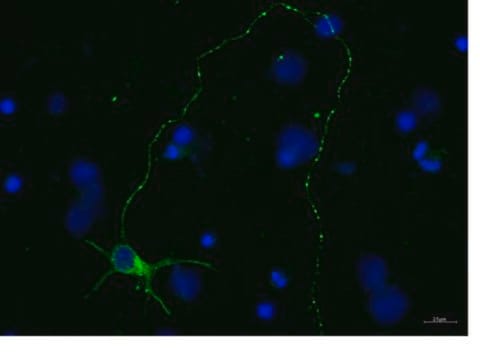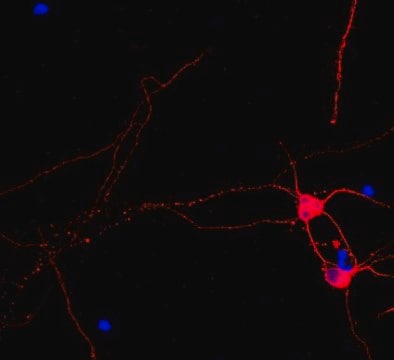CBL412A5
Anti-Tubulin β-III Antibody, clone TU-20, Alexa Fluor™555 Conjugate
clone TU-20, from mouse, ALEXA FLUOR™ 555
Synonim(y):
Tubulin beta-3 chain, Tubulin beta-4 chain, Tubulin beta-III
About This Item
Polecane produkty
pochodzenie biologiczne
mouse
Poziom jakości
białko sprzężone
ALEXA FLUOR™ 555
forma przeciwciała
purified immunoglobulin
rodzaj przeciwciała
primary antibodies
klon
TU-20, monoclonal
reaktywność gatunkowa
rat, pig
reaktywność gatunkowa (przewidywana na podstawie homologii)
primate (based on 100% sequence homology), bovine (based on 100% sequence homology), mouse (based on 100% sequence homology), porcine (based on 100% sequence homology)
metody
immunocytochemistry: suitable
izotyp
IgG1
numer dostępu NCBI
numer dostępu UniProt
Warunki transportu
wet ice
docelowa modyfikacja potranslacyjna
unmodified
informacje o genach
mouse ... Tubb3(22152)
Opis ogólny
Specyficzność
Immunogen
Zastosowanie
Neuroscience
Developmental Neuroscience
Jakość
Immunocytochemistry Analysis: A 1:100 dilution of this antibody detected Tubulin β-III in rat E18 primary cortex cells.
Opis wartości docelowych
Postać fizyczna
Przechowywanie i stabilność
Komentarz do analizy
Rat E18 primary cortex cells
Informacje prawne
Oświadczenie o zrzeczeniu się odpowiedzialności
Not finding the right product?
Try our Narzędzie selektora produktów.
Kod klasy składowania
12 - Non Combustible Liquids
Klasa zagrożenia wodnego (WGK)
WGK 2
Temperatura zapłonu (°F)
Not applicable
Temperatura zapłonu (°C)
Not applicable
Certyfikaty analizy (CoA)
Poszukaj Certyfikaty analizy (CoA), wpisując numer partii/serii produktów. Numery serii i partii można znaleźć na etykiecie produktu po słowach „seria” lub „partia”.
Masz już ten produkt?
Dokumenty związane z niedawno zakupionymi produktami zostały zamieszczone w Bibliotece dokumentów.
Nasz zespół naukowców ma doświadczenie we wszystkich obszarach badań, w tym w naukach przyrodniczych, materiałoznawstwie, syntezie chemicznej, chromatografii, analityce i wielu innych dziedzinach.
Skontaktuj się z zespołem ds. pomocy technicznej








